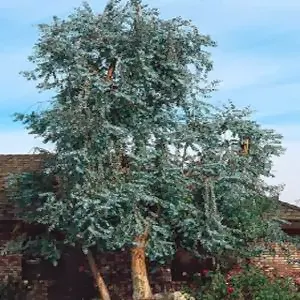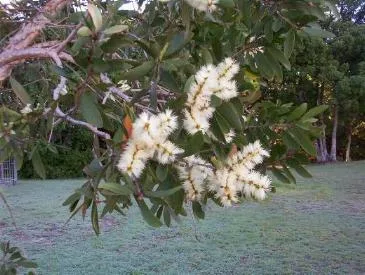By Liliana Usvat

Silver Dollar Tree: Eucalyptus cinerea.
Type: Tree. Height: To 20 feet.
Spacing: 25 feet apart. Light Requirements: Full sun.
Additional Uses: Attracts wildlife to the garden, the foliage is used in fresh cut flower arrangements as greens, and dried floral arrangements.
Eucalyptus trees are native to Australia, but they are also found in the western United States, especially in Arizona, California, and Nevada. They can be planted anywhere where there is a hot, dry climate.
Native to Australia, argyle apple or silver dollar tree is a broadleaf evergreen tree that will grow as a single trunk tree to 25-60’ tall in its native habitat.
Bark is reddish-brown, peeling on smaller stems. If grown as an annual shrub from seed in the St. Louis area, it typically grows rapidly to 6-8’ tall by mid-summer.
Juvenile foliage consists of opposite rounded silvery bluish-green leaves (to 2” long) resembling large coins, hence the common name of silver dollar tree. Foliage is aromatic. Small white flowers rarely appear on juvenile trees or container plants. Foliage stems are frequently used by florists in fresh flower arrangements.
About 150 species have been grown in areas of California and Arizona that have climates similar to the plants’ native Australian habitats; many more have been grown as solitary representatives in arboretums. Eucalypts are the most widely planted non-native trees in these two Western states—for several hundred miles in parts of California.

Propagation Methods:
From softwood cuttings
From semi-hardwood cuttings
From seed; sow indoors before last frost
Blog 124-365

Silver Dollar Tree: Eucalyptus cinerea.
Type: Tree. Height: To 20 feet.
Spacing: 25 feet apart. Light Requirements: Full sun.
Additional Uses: Attracts wildlife to the garden, the foliage is used in fresh cut flower arrangements as greens, and dried floral arrangements.
Eucalyptus trees are native to Australia, but they are also found in the western United States, especially in Arizona, California, and Nevada. They can be planted anywhere where there is a hot, dry climate.
Native to Australia, argyle apple or silver dollar tree is a broadleaf evergreen tree that will grow as a single trunk tree to 25-60’ tall in its native habitat.
Bark is reddish-brown, peeling on smaller stems. If grown as an annual shrub from seed in the St. Louis area, it typically grows rapidly to 6-8’ tall by mid-summer.
Juvenile foliage consists of opposite rounded silvery bluish-green leaves (to 2” long) resembling large coins, hence the common name of silver dollar tree. Foliage is aromatic. Small white flowers rarely appear on juvenile trees or container plants. Foliage stems are frequently used by florists in fresh flower arrangements.
About 150 species have been grown in areas of California and Arizona that have climates similar to the plants’ native Australian habitats; many more have been grown as solitary representatives in arboretums. Eucalypts are the most widely planted non-native trees in these two Western states—for several hundred miles in parts of California.

Propagation Methods:
From softwood cuttings
From semi-hardwood cuttings
From seed; sow indoors before last frost
Blog 124-365







 (cheese tree fruit)
(cheese tree fruit)  (cheese tree fruit)
(cheese tree fruit) (cheese tree)
(cheese tree) (cheese tree fruit)
(cheese tree fruit) magenta lilly pilly (Syzygium paniculatum)
magenta lilly pilly (Syzygium paniculatum) paperbark (Melaleuca quinquenervia)
paperbark (Melaleuca quinquenervia) (Rhodomyrtus Flower)
(Rhodomyrtus Flower) (Rhodomyrus Bush)
(Rhodomyrus Bush)




















